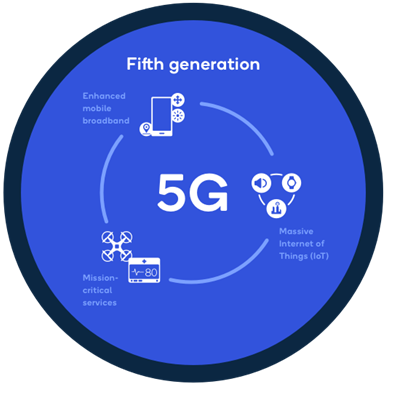The 5G Conundrum
Context: Since the dawn of mobile communication in the early 1980s, companies and consumers have been adapting to new ways of sending and receiving information.
How has technology evolved?
- The first-generation technology of this era let people make and receive phones calls through their mobile handheld devices
- The second and third generations added text and multimedia messaging, as well as email services to cell phones.
- The emergence of 4G in the early part of the past decade changed the mobile-telephone landscape. This paradigmatic shift lets users stream and download videos at speeds three times greater than 3G.
Need for 5G
- According to data intelligence firm Statista, the total number of smartphone users in the world has nearly doubled in the last seven years to 6.6 billion in 2022, from 3.7 billion in 2016. This number is estimated to rise by another billion by 2027, add a few billion wearables and Internet of Things (IoT) devices to this mix, the result is a massive data hungry world of gadgets.
- As the number of connected devices rises, so does our dependence on them to do daily tasks.
- The number of devices and things connected to the internet is not confined to the consumer world.
- Enterprises are also moving to digital channels and optimising the way tasks get done with the help of Artificial Intelligence (AI), Machine Learning (ML), predictive maintenance, and other environmental condition monitoring sensors.
- For these devices to work in sync with several other applications far superior networking and connectivity is needed and the decade-old LTE-based generation is ill-prepared to handle workloads and real-time data processing of this magnitude.
How is 5G better than 4G?
- 5G offers low latency, greater download speeds coupled with the ability to connect multiple devices and exchange data in real-time.
- Building on the multiplexing technology of its predecessor, 5G ushers in a new standard called 5G New Radio (NR), which uses the best capabilities of LTE.
- 5G NR will enable increased energy savings for connected devices and enhance connectivity.
- Apart from this, the fifth-generation of mobile communication will use high-frequency millimetre wave (mmWave) bands that operate on wavelengths between 30 GHz and 300 GHz. For comparison, 4G’s LTE operates on wavelengths under 6 GHz.
What are the issues in 5G deployment?
- While 5G has been around since the late 2010s, it didn’t reach the kind of ubiquity its predecessor enjoyed until the mid-2020s.
- That’s because there are fewer 5G-compatible devices in the market compared to 4G ones, and a delayed auctioning and rollout of 5G airwaves is holding people back from using the service.
- A 5G-based connected future is upon us. That means deploying services based on the latest generation in a world filled with 4G compatible devices.
What are the Options?
So, telecom operators and businesses looking to build their services on 5G have two options. They can either build a non-standalone (NSA) or a standalone architecture.
Non-standalone (NSA)
-
- In an NSA framework, the operator can use their existing installed capacities and LTE architecture to deploy 5G services while implementing a new radio access network (RAN).
- For Example, Germany, used the NSA model to roll out 5G services in 2019. It is not as fast as pure 5G, but achieved the purpose of providing broad national coverage to a large proportion of the population and that too in a time-bound manner. The national carrier has now started testing 5G SA architecture in select settings.
- This short-to-medium term strategy can help operators reduce capital expenditure and lower operating costs that may arise from installing a new core network.
- Standalone model
- The SA model is a pureplay 5G architecture that provides operators with a full range of the fifth-generation’s capability and lets them slice the network.
- S.-based Dish Network Corporation deployed a standalone 5G network in 2021.
- Reliance Industries Limited plans to expand its 5G network to “every town” in India by the end of 2023. The firm plans to implement 5G SA architecture to provide better performance than an NSA based set up.
Different countries and firms are at various stages of 5G deployment. The switch to a pureplay 5G SA architecture is no longer a question of whether or not, but when and how. Telecom operators will drive 5G deployment towards a standalone future in the next few years. And just like how the mobile device-based communication era made people adapt to the new technology four decades ago, 5G could potentially make consumers connect and exchange information in a new way.
| Practice Question
1. How is 5g better than 4g? What is its role in governance and public policy? |




